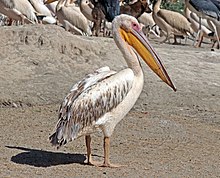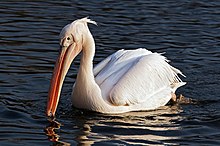Great white pelican
| Great white pelican | |
|---|---|

| |
| in Lake Ziway, Ethiopia | |
| Scientific classification | |
| Domain: | Eukaryota |
| Kingdom: | Animalia |
| Phylum: | Chordata |
| Class: | Aves |
| Order: | Pelecaniformes |
| Family: | Pelecanidae |
| Genus: | Pelecanus |
| Species: | P. onocrotalus
|
| Binomial name | |
| Pelecanus onocrotalus | |

| |
| Range of P. onocrotalus Breeding Resident Non-breeding
| |
The great white pelican (Pelecanus onocrotalus) also known as the eastern white pelican, rosy pelican or simply white pelican is a bird in the pelican family. It breeds from southeastern Europe through Asia and Africa, in swamps and shallow lakes.
The great white pelican has been rated as a species of
Description



The great white pelican is a huge bird—only the
The male has a downward bend in the neck and the female has a shorter, straighter beak. The
The juvenile has darker, brownish underparts that are palest at the rump, center of the belly, and
The great white pelican is distinguished from all other pelicans by its plumage. Its face is naked and the feathering on its forehead tapers to a fine point, whereas other species are completely feathered. In flight, the white underwing with black remiges of the adult are similar only to those of the American white pelican (P. erythrorhynchos), but the latter has white inner secondary feathers.[8] It differs from the Dalmatian pelican in its pure white – rather than greyish-white – plumage, a bare pink facial patch around the eye, and pinkish legs.[15] The spot-billed pelican (P. philippensis) of Asia is slightly smaller than the great white pelican, with greyish tinged white plumage, and a paler, duller-colored bill.[5] Similarly, the pink-backed pelican (P. rufescens) is smaller, with brownish-grey plumage, a light pink to off-grey bill, and a pinkish wash on the back.[15]
The bird is mostly silent but has a variety of low-pitched lowing, grunting, and growling calls. The flight call is a deep, quiet croak.,[15] while at breeding colonies, it gives deep moooo calls.[2]
Distribution and habitat



The breeding range of the great white pelican extends to Ethiopia, Tanzania, Chad, northern Cameroons, and Nigeria in Africa, and has been observed or reported breeding in Zambia, Botswana, and South Africa.[16] In the 1990s, 6,700 to 11,000 breeding pairs in 23 to 25 breeding sites, were found in the Palearctic region.[17] A 1991 study noted about 3,070 to 4,300 pairs were present in the Soviet Union.[18] Only two breeding colonies are located in the Mediterranean basin, one having 250 to 400 pairs in Turkey and the other having 50 to 100 pairs in northern Greece.[17] The breeding colony at Lake Rukwa, Tanzania is the largest known breeding colony in Africa, followed by the Lake Shala, Ethiopia colony which is probably of crucial importance to the species in Africa.[16]
The African population of about 75,000 pairs of the great white pelican is resident.
Overall, the great white pelican is one of the most widely distributed species. Although some areas still hold quite large colonies, it ranks behind the brown pelican and possibly the Australian pelican in overall abundance.[3] Europe now holds an estimated 7,345–10,000 breeding pairs, with over 4,000 pairs that are known to nest in Russia. During migration, more than 75,000 have been observed in Israel and, in winter, over 45,000 may stay in Pakistan. In all its colonies combined, 75,000 pairs are estimated to nest in Africa.[3] It is possibly extinct in Serbia and Montenegro, and regionally extinct in Hungary.[1]
Great white pelicans usually prefer shallow, (seasonally or tropical) warm
Behavior


The great white pelican is highly sociable and often forms large flocks.[15] It is well adapted for aquatic life. The short strong legs and webbed feet propel it in water and aid a rather awkward takeoff from the water surface. In flight, it is an elegant soaring bird, with the head held close to and aligned with the body. Its flight consists of a few slow wingbeats followed by a glide.[11] Once aloft, the long-winged pelicans are powerful fliers, however, and often travel in spectacular linear, circular, or V-formation groups.[11]
Feeding
The great white pelican mainly
The pelican's pouch serves simply as a scoop. As the pelican pushes its bill underwater, the lower bill bows out, creating a large pouch which fills with water and fish. As it lifts its head, the pouch contracts, forcing out the water but retaining the fish. A group of 6 to 8 great white pelicans gather in a horseshoe formation in water to feed together. They dip their bills in unison, creating a circle of open pouches, ready to trap every fish in the area. Most feeding is cooperative and done in groups, especially in shallow waters where fish schools can be corralled easily, though they may also forage alone as well.[3]
Great white pelicans are not restricted to fish, however, and are often opportunistic foragers. In some situations, they eat chicks of other birds, such as the well documented case off the southwest coast of South Africa.[21] Here, breeding pelicans from the Dassen Island prey on chicks weighing up to 2 kg (4.4 lb) from the Cape gannet colony on Malgas Island.[22] Similarly, in Walvis Bay, Namibia the eggs and chicks of Cape cormorants are fed regularly to young pelicans. The local pelican population is so reliant on the cormorants, that when the cormorant species experienced a population decline, the numbers of pelicans appeared to decline as well.[3]
They also
Breeding

The breeding season commences in April or May in temperate zones, is essentially all year around in Africa, and runs February through April in India. Large numbers of these pelicans breed together in colonies. Nest locations vary: some populations make stick nests in trees but a majority, including all those that breed in Africa, nest exclusively in scrapes on the ground lined with grass, sticks, feathers, and other material.[20]
The female can lay from 1 to 4 eggs in a clutch, with two being the average.[3] Incubation takes 29 to 36 days. The chicks are naked when they hatch but quickly sprout blackish-brown down. The young are cared for by both parents. The colony gathers in "pods" around 20 to 25 days after the eggs hatch. The young fledge at 65 to 75 days of age. Around 64% of young successful reach adulthood, attaining sexual maturity at 3 to 4 years of age.[3]
Predators
Predators of the pelicans' eggs and chicks include mammalian animals like foxes, gulls, frigatebirds, crows, skuas, African fish eagles (Haliaeetus vocifer), and marabou storks (Leptoptilos crumenifer). The adults have few predators on land other than humans and has no marine predator. However, in some regions of Africa, terrestrial predation occurs at night while roosting, caused by jackals, hyenas and lions.[25][26][27] Additionally, crocodiles, especially Nile crocodiles reportedly taken swimming pelicans.[28]
Status and conservation
Since 1998, the great white pelican has been rated as a species of
Today, because of
References
- ^ . Retrieved 12 November 2021.
- ^ ISBN 9781770072435.
- ^ ISBN 978-84-87334-10-8.
- ISBN 978-0-85661-079-0.
- ^ ISBN 9780199639434.
- ISBN 978-0-85112-235-9.
- ISBN 978-0-395-60291-1.
- ^ a b c d Elliott, A.; Christie, D.A.; F., Jutglar; E.F.J., Garcia; Kirwan, G.M. (2017). del Hoyo, Josep; Elliott, Andrew; Sargatal, Jordi; Christie, David A.; de Juana, Eduardo (eds.). "Mangrove Swallow (Tachycineta albilinea)". Handbook of the Birds of the World Alive. Barcelona: Lynx Edicions. Retrieved August 23, 2017.
- ISBN 978-1-4200-6444-5.
- ^ Johnsgard, P. A. (1993). Cormorants, darters, and pelicans of the world. Smithsonian Inst Pr.
- ^ ISBN 9781472946003.
- ^ Mclachlan, G.R.; Liversidge, R. (1978). "42 White Pelican". Roberts Birds of South Africa. Illustrated by Lighton, N.C.K.; Newman, K.; Adams, J.; Gronvöld, H. (4th ed.). The Trustees of the John Voelcker Bird Book Fund. pp. 23–24.
- ^ ISBN 9780199585663.
- ISBN 9780713688009.
- ^ ISBN 9781408135235.
- ^ ISSN 1474-919X.
- ^ S2CID 86109828.
- ^ Crivelli, Alain J.; Leshem, Yossi; Mitchev, Taniu; Jerrentrup, Hans (1991). "Where Do Palaearctic Great White Pelicans (Pelcanus Onocratalus) Presently Over Winter ?" (PDF). Revue d'Écologie. 46.
- ISSN 0030-6525.
- ^ a b Crawford, R.J.M. (2005). "Great White Pelican". In Hockey, P.A.R.; Dean, W.R.J.; Ryan, P.G. (eds.). Roberts – Birds of Southern Africa (7th ed.). Cape Town: The Trustees of the John Voelcker Bird Book Fund. pp. 614–615.
- ^ Attenborough, David (2009). "Birds". Life. Episode 5. BBC. Retrieved 25 December 2014.
- ^ Ryan, P. (2007). "Going, going, Gannet...Tough times for Benguela Seabirds" (PDF). African Birds & Birding: 30–35. Archived from the original (PDF) on 2012-10-30.
- ^ "Pelican Swallows Pigeon in Park". BBC News. 25 October 2006. Retrieved 25 October 2006.
- ^ Clarke, James (30 October 2006). "Pelican's Pigeon Meal not so Rare". BBC News. Retrieved 5 July 2007.
- ^ Brown, Leslie Hilton, and Emil K. Urban. "The breeding biology of the great white pelican Pelecanus onocrotalus roseus at Lake Shala, Ethiopia." Ibis 111.2 (1969): 199-237.
- ^ a b c Bowker, Meyrick Brabbin. Conservation of the great white pelican (Pelecanus onocrotalus) and the pink-backed pelican (P. rufescens) in south eastern Africa. Diss. 2006.
- ^ ADW- Pelecanus onocrotalus - Information (2011).
- ISBN 978-0-8160-2174-1.
- ^ Anonymous. "Proposal for Inclusion of Species on the Appendices of the Convention on the Conservation of Migratory Species of Wild Animals" (PDF). Government of the Federal Republic of Germany. Archived from the original (PDF) on 2017-08-02. Retrieved 2017-08-02.
- ^ "Pelicans". Royalparks. Retrieved 25 December 2014.
External links
- (Great) White Pelican Species text in The Atlas of Southern African Birds
- BirdLife species factsheet for Pelecanus onocrotalus
- "Pelecanus onocrotalus". Avibase.
- "Great white pelican media". Internet Bird Collection.
- Great white pelican photo gallery at VIREO (Drexel University)
- Interactive range map of Pelecanus onocrotalus at IUCN Red List maps
- Audio recordings of Great white pelican on Xeno-canto.
- Educational article with video about Great White Pelican

